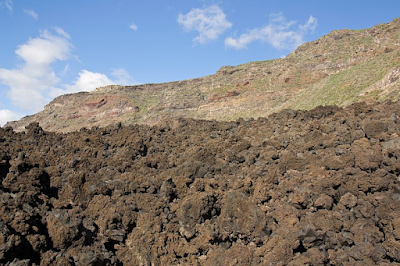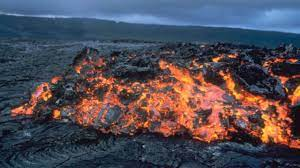Aa lava is a rough rubbly crust of a lava flow. It is a major lava flow type. Other important subaerial lava flow types are pahoehoe and blocky lava.
Aa and pahoehoe are terms that were brought to geological terminology from the Hawaiian language. Aa is according to native Hawaiians a sound one makes if he or she tries to walk barefoot on such a lava flow. There are different spelling versions, ‘a’a, a’a, a-aa are used as well as simple aa. Pahoehoe means in Hawaiian “on which one can walk”.
Walking on it is very slow and potentially dangerous even if one has good hiking boots. It is such a miserable experience because the uppermost part of aa lava is composed of loose clinkery unstable blocks. You can never be sure that the rocks you are stepping on do not move. They often do. This means that ground beneath your feet is unstable and you may easily lose balance. It is no good if that happens because the edges of fresh aa lava rubble may be very sharp. Sometimes aa lava blocks are so big that one has to climb over them. It makes moving progress very slow and bare hands will get scratched for sure.
One thing that in my opinion is often poorly understood is the fact that aa and pahoehoe are terms that only describe the upper part of a lava flow. It is more correct to say that aa lava is a type of lava flow crust, not lava flow itself. Both aa lava and pahoehoe are usually massive beneath the crust which may be smooth (pahoehoe) or rubbly (aa). Massive part usually contains vesicles (gas bubbles) which will fill with secondary minerals like zeolites in older lava flows. This process takes considerable time and requires low-temperature hydrothermal alteration. There are no amygdules (vesicle filling mineral masses) in historic lava flows.
Aa lava is more common than pahoehoe. Special conditions are needed for pahoehoe to form: lava with low viscosity (high temperature, low silica content), low effusion rate, and gentle slope. Aa lava is free of such restrictions and therefore forms instead of pahoehoe if the conditions are not right. It is usually the speed of advancing lava flow that determines whether aa or pahoehoe forms and that depends on the effusion rate and steepness of the slope. It has been shown that flow rates exceeding 5-10 m3/s clearly favors the formation of aa lava over pahoehoe on Hawaii3. Once aa lava is formed it never reverts back to smooth pahoehoe form.
This beautiful cascade of lava in Hawaii is largely composed of pahoehoe type lava flow, but in the left-hand side some lava tongues have broken to form aa instead of pahoehoe.
Pahoehoe lava flow in the center that have partially covered the aa-type flow in Hawaii.
Pahoehoe lava flow in the center that have partially covered the aa-type flow in Hawaii.
Lava flow formed in 1949 on La Palma in the foreground. It is almost completely aa lava. Pahoehoe forms only small part of it.

Here is a nice exposure near the southern tip of La Palma which shows the internal structure of aa lava. Here are two lava flows. Lower part of the flow is massive lava which has a rubbly surface. And on top of it is another aa lava flow.

The interior of a lava flow may be columnar because of thermal contraction. However, really beautiful regularly shaped columns like these form usually in a stationary well insulated lava lake not in an actively moving lava flow. Giant’s Causeway, Northern Ireland.
Below is a video of a fabulous a'a lava flow from Kilauea. Listen closely - you can hear a sound like a hundred champagne glasses breaking. Those are the clinkers, cooled bits of lava tumbling from atop the flow.
There's an excellent write-up of basalt lava flows here that will explain the whole clinker-thing. Read that, then come back for some more fun with clinkery a'a flows.
Full of Hawaiian lava flows wwith surfer music, a'a tumbling into the sea at night while surfer-type music plays merrily.












No comments:
Post a Comment